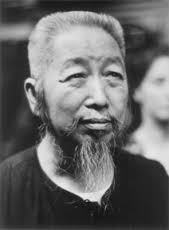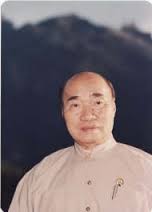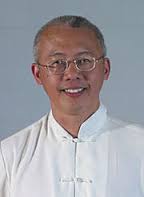Our Tai ji Chuan lineage
The history of Yang style Tai ji chuanThe beginning of Tai ji chuan
The beginnings of Tai ji are shrouded in myth. What is known is that it goes back to, at least, the 13th century. Some have suggested that it was an adaptation of Indian boxing brought to China by Buddhist monks. That would mean it actually has links to Greek boxing as Indian boxing was introduced from the Hellenistic cities of Afghanistan.
Eventually a uniquely Chinese flavour was created by the introduction of formal styles and positions. For quite some time there were no forms as we now know them. Rather positions were taught. Along with their applications. The combination became known as Tai ji chuan - supreme ultimate fist.
The Chen family - from the 14th century
As far as can be seen the Chen family first developed a set of movements that go from position to position in a constant flow. Thus introducing the form as it is now known.
The Chen family attempted to keep their style, and principles, secret. Chen forms vary from very flowing to ones where speed varies and some moves can be quite "explosive".
The Yang family - from 1799
Yang Lu-Chan developed the Yang style from the Chen style. He was reputed to have learned by watching the Chen family practice and then practicing on his own.
The Yang style was taken to Beijing where it was introduced to the empire's mandarins and was progressively changed to make the movements less physically demanding.
In the 1920s Yang Cheng-fu developed the "Big Style" that has become the dominant Tai ji style learned world-wide. This form (with some modifications) is taught to more advanced students in our school.
Cheng Man-Ch'ing learned his Tai ji from Yang Cheng-fu and was his last disciple.
Cheng Man-Ch'ing (1900 - 1975)
 Grand Master Cheng developed the 37 pattern short form. This form decreased both the number of movements and the size of those movements. This form is the first one taught to beginners in our school.
Grand Master Cheng developed the 37 pattern short form. This form decreased both the number of movements and the size of those movements. This form is the first one taught to beginners in our school.
GM Cheng introduced his form to the west when he went to New York in the nineteen-seventies. He also emphasised the need to teach all the "secrets" to all students and not just inner students.
A key aspect of GM Cheng's form is the importance of softness and connection. Previously these had been part of the "inner secrets" that were only taught to disciples. In looking at a comparison between Cheng's form and the traditional Yang form the the idea of softness can be seen in the fact that the wrists are, generally, held straight.
An important idea taught by GM Cheng is the importance of concentrating on a small number of movements. This is one of the reasons why he decreased the number of movements in the form. However he kept the repetitions of the ward off, roll back press and push sequence as (in his own words) "These are the essence of Tai ji."
Huang Xiang-Xian (1910 - 1992)
 Grand Master Huang Xiang-Xian modified Cheng's 37 pattern form to make it somewhat more applicable as a martial art.
Grand Master Huang Xiang-Xian modified Cheng's 37 pattern form to make it somewhat more applicable as a martial art.
GM Huang taught Wee Kee Jin. He further modified the 37 pattern form to make some movements more applied. He was originally a practitioner of Fujian White Crane and has passed the tradition on to Wee Kee Jin.
GM Huang has been considered by some to have been the most advanced of Cheng's students. As part of the modification of the 37 pattern form GM Huang introduced certain moves that are derived from Fujian White Crane. For example the slant flying between repulse monkey and waving hands in the clouds.
These modifications are even more apparent in the 72-pattern form. In this form transitions are made more directly and certain movements (for example the rotation in the transition between roll back and single whip) are clearly derived directly from White Crane Kung fu.
One of GM Huang's jokes was "I have put some Kung fu into my Tai ji. That confuses the Tai ji people. I have put some Tai ji into my Kung fu. That confuses the Kung fu people."
A main distinction between GM Huang's teaching and that of GM Cheng's is his emphasis on the use of the reverse rotation. This, amongst everything else, marks GM Huang derived forms from those of his predecessors.
Wee Kee-Jin (1956 -)
 Wee Kee Jin was the last of GM Huang's private inner students and spent 4 years living with him. He came to New Zealand at GM Huang's behest to set up schools here.
Wee Kee Jin was the last of GM Huang's private inner students and spent 4 years living with him. He came to New Zealand at GM Huang's behest to set up schools here.
Jin's approach is both informal and demanding. When training with him it is clear he has high standards and expects his pupils to attain them. At the same time his approach is friendly and informal and he doesn't stint in providing deep insights into Tai ji principles and practice.
Because of his informal style students can learn at their own pace. This is a tradition our school has adopted and is the main reason why we prefer class sizes to be small.
Jin is always improving his own Tai ji and expects his pupils to do so. One of his favourite sayings (derived from GM Huang) is : "If you think you've mastered Tai ji you have no more to learn. Therefore you must be dead. Give me a shovel so I can bury you."
This is a hard lesson for many to learn as we tend to like to think we have reached a certain level and have nothing more to learn that is "below" that level. This is an error. We must never leave the foundations of Tai ji behind as they are the key to any progress in the art.
Alan Jeffery (1951 - )
Alan Jeffery has been learning Tai ji and White Crane Kung Fu for over 30 years. He is the senior teacher of the Whangarei Tai ji school. Originally he started to learn it because of damage to his right knee that prevented him from continuing to do Shotokan Karate.
Alan started learning with Wee Kee-Jin when he first came out to New Zealand in 1991. Every weekend he went to Auckland to train with Jin and his other students. In 1995 Jin authorised Alan to teach Tai ji and Fujian kung fu.
As well as learning the 37 pattern Alan has learned GM Huang's 72 pattern, the 108 pattern form, Tai ji staff, sword and stick forms. Alan is still improving all of these. There is no such thing as "No more to learn." And his students contribute in no small way to that learning.
Our style is based on the Yang style and further adapted by Cheng Man Ching and Master Huang Xiang Xian. Our emphasis is on the principles and the application of internal awareness in movements. As a result our Tai ji can be used for both health and as a martial art.